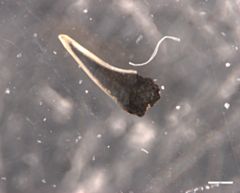Project 3589: I. Leonhard, B. Shirley, D. J. Murdock, J. Repetski, E. Jarochowska. 2021. Growth and feeding ecology of coniform conodonts. PeerJ. 9:e12505.
Abstract
Conodonts were the first vertebrates to develop mineralized dental tools, known as elements. Recent research suggests that conodonts were macrophagous predators and/or scavengers but we do not know how this feeding habit emerged in the earliest coniform conodonts, since most studies focus on the derived, ‘complex’ conodonts. Previous modelling of element position and mechanical properties indicate they were capable of food processing. A direct test would be provided through evidence of in vivo element crown tissue damage or through in vivo incorporated chemical proxies for a shift in their trophic position during ontogeny. Here we focus on coniform elements from two conodont taxa, the phylogenetically primitive Proconodontus muelleri Miller, 1969 from the late Cambrian and the more derived Panderodus equicostatus Rhodes, 1954 from the Silurian. Proposing that this extremely small sample is, however, representative for these taxa, we aim to describe in detail the growth of an element from each of these taxa in order to the test the following hypotheses: (1) Panderodus and Proconodontus processed hard food, which led to damage of their elements consistent with prey capture function; and (2) both genera shifted towards higher trophic levels during ontogeny. We employed backscatter electron (BSE) imaging, energy-dispersive X-ray spectroscopy (EDX) and synchrotron radiation X-ray tomographic microscopy (SRXTM) to identify growth increments, wear and damage surfaces, and the Sr/Ca ratio in bioapatite as a proxy for the trophic position. Using these data, we can identify whether they exhibit determinate or indeterminate growth and whether both species followed linear or allometric growth dynamics. Growth increments (27 in Pa. equicostatus and 58 in Pr. muelleri) were formed in bundles of 4–7 increments in Pa. equicostatus and 7–9 in Pr. muelleri. We interpret the bundles as analogous to Retzius periodicity in vertebrate teeth. Based on applied optimal resource allocation models, internal periodicity might explain indeterminate growth in both species. They also allow us to interpret the almost linear growth of both individuals as an indicator that there was no size-dependent increase in mortality in the ecosystems where they lived e.g., as would be the case in the presence of larger predators. Our findings show that periodic growth was present in early conodonts and preceded tissue repair in response to wear and damage. We found no microwear and the Sr/Ca ratio, and therefore the trophic position, did not change substantially during the lifetimes of either individual. Trophic ecology of coniform conodonts differed from the predatory and/or scavenger lifestyle documented for “complex” conodonts. We propose that conodonts adapted their life histories to top-down controlled ecosystems during the Nekton Revolution.Read the article »
Article DOI: 10.7717/peerj.12505
Project DOI: 10.7934/P3589, http://dx.doi.org/10.7934/P3589
| This project contains |
|---|
Download Project SDD File |
Currently Viewing:
MorphoBank Project 3589
MorphoBank Project 3589
- Creation Date:
19 November 2019 - Publication Date:
03 November 2021 - Media downloads: 3

Authors' Institutions ![]()
- University of Oxford
- Universitaet Erlangen Nuernberg
- Universiteit Utrecht
- US Geological Survey
- Friedrich-Alexander-Universität Erlangen-Nürnberg
- Oxford University Museum of Natural History
Members
| member name | taxa |
specimens |
media |
| Isabella Leonhard Project Administrator | 4 | 8 | 14 |
| Emilia Jarochowska Full membership | 0 | 0 | 0 |
| Duncan Murdock Full membership | 0 | 0 | 0 |
| Bryan Shirley Full membership | 0 | 0 | 0 |
Project has no matrices defined.
Project downloads 
| type | number of downloads | Individual items downloaded (where applicable) |
| Total downloads from project | 32 | |
| Project downloads | 29 | |
| Media downloads | 3 | M821742 (3 downloads); |

